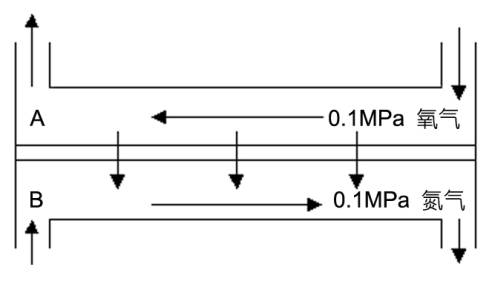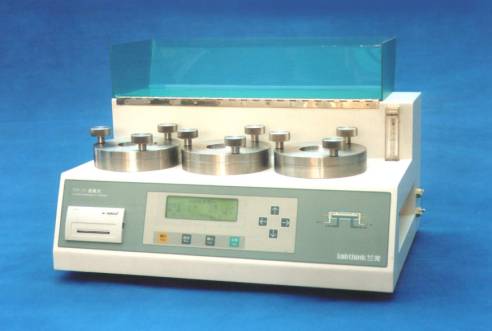Oxygen Permeability Test of Film by TOY-C1
Perhaps you have heard about TOY-C1, the newly introduced Labthink permeability instrument this year. Definitely, due to its professional function in package oxygen permeability testing, TOY-C1 has become a highlight in domestic permeability testing industry. Its debut on the package exhibition of south China Guangzhou Pazhou in March 2005 has attracted great public attention, which not only fills the gap of domestic package permeability testing industry, but also promotes Labthink's status in international permeability testing fields.
In actual production, container package manufacturers will sometimes need the testing of oxygen transmission rate for sheets and films, and such testing demand can be very heavy sometimes. It is indeed necessary for those who have purchased container package oxygen permeability instrument alone to further buy one film oxygen permeability tester. For such users, it is an optimum choice if the instrument can function as both container package oxygen permeability tester and film oxygen permeability tester. In this way, not only the expenditure of capital can be reduced, utilization ratio of the instrument is also improved.
1. Test Principle
As stated in standard ASTM F 1307, this test method employs a coulometric oxygen sensor and associated equipment in an arrangement similar to that described in Test Method ASTM D3985. Oxygen permeability of sheet and film can be tested according to standard ASTM D3985 when removing the instrument's container package testing accessories. It is according to these two standards that Labthink TOY-C1 has been designed and manufactured. Users can perform film oxygen permeability testing in equal pressure method. The testing principle is (see fig 1): the specimen divides testing chamber into chamber A and chamber B with chamber A with 0.1MPa pure oxygen gas at certain flow rated and chamber B being purged by 0.1MPa nitrogen gas at certain flow rate. When oxygen transmits through the specimen from chamber A into chamber B, it will be diverted into the sensor by nitrogen carrier gas in chamber B. Oxygen transmission rate contained in the nitrogen gas is detected by the sensor and then output as corresponding electrical signals.

Fig. 1. Test principle of equal pressure method
2. Film Testing
Film specimen sampling and clamping is similar to that of the equal pressure method which is simple and convenient. To facilitate specimen sampling, TOY-C1 is furnished with special film specimen cutter. Fig. 2 shows the status that specimens have been clamped.

Fig.2. TOY-C1 Specimen Clamping of Film Oxygen Permeability Testing
The dimension of specimen is φ 140mm. If thickness of specimen exceeds 1mm, corresponding accessories are needed in the process of clamping. TOY-C1 can perform three-chamber testing, but it should be noted that all specimen clamped in one testing must be completely the same from the same material. In the process of clamping, specimen edge should be sealed with vacuum grease. Pay attention not to contaminate testing area by vacuum grease.
Testing process is almost the same with that of the container package oxygen permeability testing: purge the system to identify the value of ‘system zero point'. Then, divert oxygen gas into the upper chamber; output value of the sensor will gradually increase which is an indication that there is oxygen transmitting through the specimen into chamber B. When the oxygen gas transmission rate (O2GTR) maintains at a constant value, it can be considered as equilibrium of transmission and that O2GTR is the test result.
Whether the flow rate of nitrogen gas is appropriate during testing will directly influence the test result. Therefore, this instrument has higher demand for controlling device and flowmeter of nitrogen flow rate.
3. Data Testing and Stability
Measurement range of TOY-C1 is 0~1000.00ml/m2·day (extended to 0~10000.00ml/m2·day with special subassembly). Its testing resolution can reach 0.01ml/m2·day. The testing curve is shown in fig.3.

Fig.3 Testing Curve of Film Permeability Testing
A, B, C and D are the specimens chosen for TOY-C1 oxygen permeability testing. Testing temperature, specimen thickness and testing results are listed in table 1.
Table 1. Data Sheet of Testing
|
Specimen |
Thickness μ m |
O2GTR Measured Data |
O2GTR (mean) |
S |
CV% |
Testing Temperature °C |
|
A |
20 |
6.29 |
6.44 |
0.14 |
2.13 |
23 |
|
6.47 | ||||||
|
6.56 | ||||||
|
B |
20 |
10.37 |
12.17 |
1.59 |
13.08 |
23 |
|
13.38 | ||||||
|
12.77 | ||||||
|
C |
20 |
32.66 |
33.15 |
0.44 |
1.33 |
23 |
|
33.27 | ||||||
|
33.52 | ||||||
|
D |
25 |
46.36 |
49.97 |
3.98 |
7.97 |
23 |
|
49.30 | ||||||
|
54.24 |
Note: unit of O2GTR is ml/m2·day.
Generally speaking, TOY-C1 data features a better stability. There are mainly two factors that influence data stability: one is the nonuniformity of specimen thickness. Data stability can be significantly improved if the specimens are uniform in thickness and operators pay some attention to specimen selection in specimen sampling. The other factor is that temperature fluctuation has great influence on testing. The influence of temperature on equal pressure method is the same as that on differential pressure method. Those who are interested can refer to the article named Influence of Temperature Fluctuation on Material Permeability updated on January 21st, 2005 in Labthink Lab Forum.
4. Instrument Features
Under normal conditions, oxygen sensor adopted by TOY-C1 has an expected lifespan of twelve to thirty months, which reduces testing cost effectively. If specimen number is less than three, the instrument can perform normal testing after the instrument self-furnished ‘blank specimen' is prepared for clamping in those testing chambers that does not need specimen attachment and then, modify specimen number in system setting. In this way, sensor lifespan is prolonged while measuring range of the instrument is extended.
Testing process will not be affected by power failure. The only influence of power failure is the inability of testing monitor. Moreover, this instrument has a smaller consumption power, which is less than 30W under normal working conditions.
Link:http://service.labthink.cn/en/article-Permeation-info-110118119.html
Labthink Copyrights. Please do not copy without permission! Please indicate source when copy.
Relating Articles
- Overall Realization of Comprehensive Mechanical Testing on Pharmaceutical Packaging and Medical Devices
- Further Improvements on Performance of Weighing Method Water Vapor Transmission Rate Tester
- Verification Tests for Barrier Property of Starch-based Biodegradable Packaging
- TAPPI standard
- BS standard
Member Registration and Login In
| If you are already a member of us, please login in! | If you are not a member of us, please register for free! | ||
·Forget password? |
|
·Terms and Conditions If you have questions, please phone 86-531-85811021 |
|

